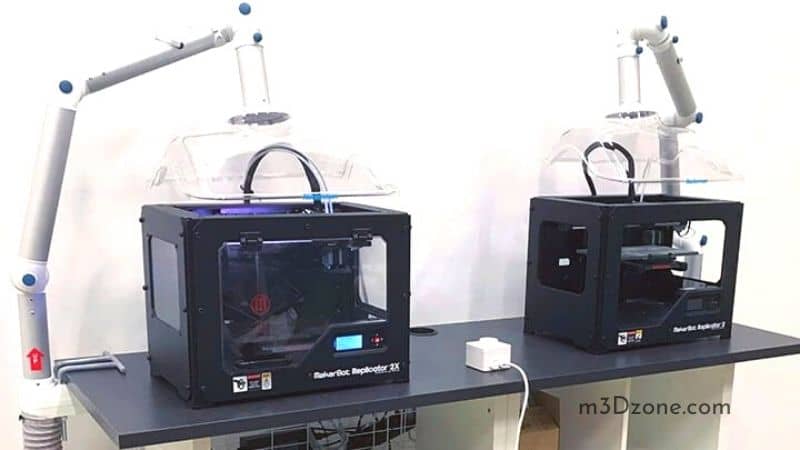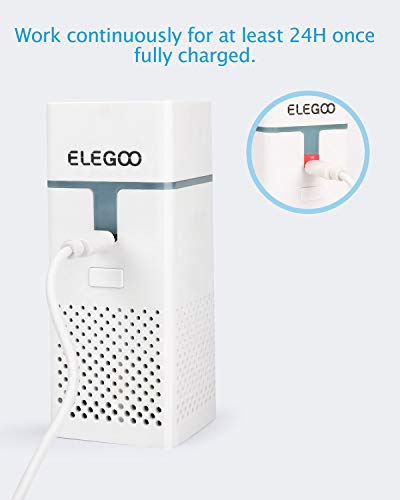3D printing popularity attracts many printing hobbyists to the industry. However, the 3D printers heat plastic filaments to create objects in the 3D printing process.

As an Amazon Associate, I earn from qualifying purchases. If you make a purchase after clicking on a link I may earn a small commission at no extra cost to you.
Quick Navigation
The Need For 3D Printing Fume Extraction
The heated plastic filaments emit gas and ultra-fine particles (UFP). Also, the heated plastic material produces volatile organic compounds (VOCs).
The contaminants disperse around the printing space and into the atmosphere.
It is an excellent idea for hobbyists to familiarize themselves with 3D printing fume extraction methods. It will ensure 3D print safety devoid of contaminants from heated filaments from fumes.
The article is a guide for 3D printing fumes extraction as a solution to toxic fumes emission.
Does 3D Printing Give Off Fumes?
Yes! The 3D printing process emits fumes harmful to your health and safety!
Notably, the 3D printer emissions pose a contamination risk to the surrounding air. Sadly, researchers have not conducted sufficient research on this front.
However, plastic noxious fumes are carcinogenic. It means VOCs and UFPs can cause severe irritations to the respiratory system and, at worst, are cancerous.
For this reason, it is an excellent idea for professionals to create health and safety awareness among themselves and the ever-increasing 3D printing hobbyists fraternity.
Additive Manufacturing Industry
Additive manufacturing (AM) or additive layer manufacturing (ALM) refers to the industrial name of 3D printing.
The Computer-Aided Design (CAD) controls the creation of the 3D models by depositing plastic materials like PLA and ABS layer by layer.
The binder jetting technique is an additive manufacturing method that uses the hot end to move along the axes, X, Y, and Z to deposit powdered material and a liquid binder as an adhesive.
Plastic materials used for additive manufacturing produce emissions that increase respiratory system irritation exposure limits.
The chemical properties of most 3D printing plastic materials contain harmful compounds that can create health problems when heated and emitted.
Volatile Organic Compounds
Volatile organic compounds(VOCs) have a high vapor pressure and low water solubility. VOCs are prominent in chemicals used to manufacture 3D plastic filaments, paints, pharmaceuticals, and refrigerants.
VOCs are industrial insolvents that are common groundwater contaminants. More importantly, when 3D plastic material heats up, they release VOCs.
The quantity of VOCs removed depends on the printing process’s plastic filament type and duration.
Ultrafine Particles
The 3D printing process releases gases and fumes that contain ultrafine particles into the surrounding air. The 3D printer heats the plastic filament, and the activated carbon melts, producing gases.
Large particles of gases settle readily because of their size and density. Nonetheless, smaller UFP particles traverse a vast surface area before settling.
Gaseous emissions from melting plastic material in 3D printing are a health risk. However, researchers deem UFPs to pose a greater danger.
How Do You Deal With 3D Printing Fumes?
The 3D printing process can take eight hours or even days, depending on the model complexity and size.
Thus, the small number of gaseous emissions can be quite harmful if inhaled and ingested for such extended periods.
Therefore, 3D printing professionals and hobbyists need to have a clear plan and ways of dealing with odors and toxic fumes from the printing process.
Use a Well-ventilated Printing Space
If you want to 3D print, be sure to put your 3D printer in a well-ventilated print room. Choose a spacious print area with windows to dispense with fumes.
Notably, it is best to put your 3D printer in an outside space like a workshop or a garage as you minimize the chances of more people getting exposed to 3D printing fumes.
Install a Ventilation System
Install a functional ventilation system to deal with gaseous fume emissions if you intend to 3D print in the living room.
The air quality monitor helps minimize health issues by providing room air quality information during the printing session.
You can complement the air quality monitor by installing an air purifier like the HEPA filter.
These filters help you control printer fumes in your living room.
Use Fume Extractors
Using a fume extraction (check at Amazon) system to deal with harmful 3D printing fumes is a nice idea. The fume extractor is a system that uses dangerous drafts to extract fumes and dust particles to a filtration system.
Thus, the process filters and removes harmful particles in the air.
Use a Safer 3D Printer
It is a good practice to use a safer 3D printer for your 3D printing needs. Buy a printer from a reputable manufacturer with an enclosure to prevent airflow out of the printer chambers.
Equally, buy printers that use safer plastic like the PLA filaments (check at Amazon). These plastic materials contain minimal quantities of dangerous fumes hazardous to your safety and health.
Wear Personal Protective Equipment
Wearing personal protective equipment (PPE) protects you from getting into contact with contaminated surfaces and equipment.
Also, you avoid inhaling and ingesting harmful gases or fumes from the 3D printing process.
More importantly, it helps you avoid exposure to the fumes that may come into contact with your eyes, skin, and respiratory system.
Administrative Controls
Administrative controls remain one of the least used methods of controlling the dangers of harmful 3D printing fumes.
In this fumes control method, managers restrict the entrance of the 3D printing room to a few staff members. Administrators authorize only staff dealing with 3D printing to access this room.
They protect the other staff members from harmful gases from the 3D printing process.
Is 3D Printing Safe Indoors?
3D printing is not safe indoors!
The 3D printing process emits harmful fumes from heated filament material. The fumes can negatively impact indoor air quality, posing severe safety and health risks.
Generally, when the hot end heats plastic filament, it melts and generates odor and fumes due to its mechanical and chemical properties.
Furthermore, the hotter the required heat to melt the filament, the more emissions it produces.
Therefore, ABS filament produces more harmful fumes on heating because the temperature needed to thaw it is higher than PLA plastic filament.
More importantly, if you intend to 3D print indoors, choose a non-toxic filament like unmodified PLA. The filament consists of natural plants like cornstarch and sugarcane. It’s biodegradable and emits a good smell.
Also, PLA prints at a lower temperature, the product’s a small emission. But as soon as you move from unmodified PLA to the other side, ABS or even modified PLA filament, things change.
It would help if you now started taking safety and health precautions seriously. Thus, you can use a printer with a filtration system to capture and filter fumes.
Also, you can use a ventilated room or location and ensure windows are open to maximize the circulation of ambient air in the room.
Alternatively, you can use air purifiers and extractors to compliment the use of printer enclosures for indoor 3D printing.
Use printers with a pre-filter. Pre-filters for the extraction system capture dust and larger particulates before combining HEPA and Carbon filters to clean the air of 3D printing fumes.
Do You Need Ventilation When Printing PLA?
3D printer users consider printing PLA filament without a ventilation system a largely safe undertaking.
If you print at a higher printing temperature with the ABS filament, your printer will produce fumes with toxic particles.
However, printing with lower temperature filament such as PLA ensures a printer releases negligible amounts of VOCs and UFP particles.
As such, conventional wisdom demands that we take care of our safety and health needs by using a ventilation system, even with PLA.
PLA releases small amounts of nanoparticles. That’s correct! However, these small amounts of PLA harmful particles consumed and inhaled over a long period can prove detrimental in the long run.
It is an excellent idea to use a printer enclosure or create a safe print area by opening windows for fresh air.
Conclusion
3D printing fume extraction is a great ventilation system for the 3D printing industry. It works when you install the unit and switch it on.
Point the suction head of the extraction arm within a few meters of the fume base.
It is an act that will enable the print suction head to suck all the harmful fumes in a process known as filtration.
Notably, sucking the fumes into an infiltration system allows the fume extractor to separate dust from fumes. After the separation of dust and fumes is cleaned, fresh air is released back into the atmosphere.
Recommended Reading
Best ABS Print Settings for Your 3D Printer
Printing with ABS can be tricky. Let us guide you to get the best ABS print settings for your 3D printer in no time. Read on!
PVA Filament. What Is It and What Is It Used For?
PVA filament is a biodegradable polymer that remains sensitive to moisture. Comes as a support material and its chemical properties make it soluble.
Wall Thickness 3D Printing. Do It Perfectly!
What is wall thickness 3D printing? It is the distance between one side of your 3D part and its opposite surface. Recommended thickness to ensure the...



